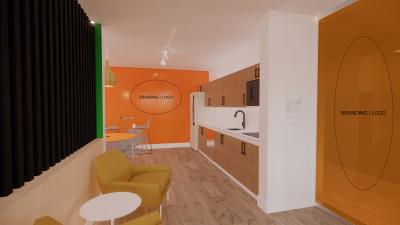
A year ago, Humber College’s Faculty of Applied Sciences & Technology (FAST) was tapped by an international client to design an Entrepreneurship Incubation Centre called HIVE.
The brief came from the government of Maldives through the Maldives Enhancing Employability and Resilience of Youth (MEERY) program.
In partnership with lead institution Seneca College, Humber’s International Development Institute (IDI) collaborated with Global Innovation & Skills Development Canada (GISDC) to implement the program with funding from the World Bank.
FAST professor Zaiba Mian and two of her students in the Bachelor of Interior Design program spent four months researching and working on a HIVE design and eventually produced a full rendering of the space that totally impressed IDI’s Jennifer Cleary.
“I never worked with design students, so the way they came up with their concept was really fascinating to me. I would never have thought they’d delve so deep into the country and pull out all these ideas that then resonated with the designer at the Entrepreneurship Centre,” said Cleary.
Before the students got started on the project, the International Development Institute’s staff briefed the students on what it’s like to work in international development and connected them with partners abroad to get a better understanding of cultural customs and workflow. They laid the groundwork for such an innovative project connecting institutions, countries and people from around the world.

Mian chose two of her most engaged students, Lily Donald and Nicola Klahre, to work on the project with her. They were used to extensive research since it’s emphasized in their program. Every studio project they produce includes a research component.
The client and location, though, were unique. HIVE is to be built in a shopping mall in the Maldives – an environment utterly foreign to the team. They often communicated with people on the ground in the Maldives over video chat.
“Being able to go to the client meetings was a great experience because I felt integrated within the design process as a whole,” said Donald, who recently graduated from the Interior Design program, along with her team member, Klahre.
The goal of the incubation hub is to improve technical and vocational training and encourage female labour force participation. HIVE also aims to nurture entrepreneurship and talent retention in the Maldives region.
The design team planned their approach to the project and then developed variations of layouts to suit the clients’ needs, preferences and budget.
“The MEERY international incubator project taught me valuable skills about interior design that will enhance my future growth in the industry,” said Klahre.
“I thoroughly enjoyed this design experience, and I am looking forward to one day seeing the final product when the design comes to life.”

The project was a success made even sweeter by the diverse number of collaborations: International, local – between Seneca, GISDC and Humber - and cross-cultural.
“In addition, I was collaborating with my students, and they were collaborating with each other. It was all virtual and actually quite seamless,” said Mian.
Like many Humber program offerings, the Interior Design degree program values collaboration with external organizations as actual clients. Part of the college’s polytechnic model includes work-integrated learning (WIL) opportunities, where students practice the skills and theory they learned in class in real-world scenarios.
The WIL mandate sets Humber apart, says Mian. The Interior Design curriculum is also dynamic, changing as the design industry and post-secondary education evolves.
To learn more about Humber’s Bachelor of Interior Design, visit the program website.
For more information on Humber’s IDI and international development work, visit www.idi.humber.ca.